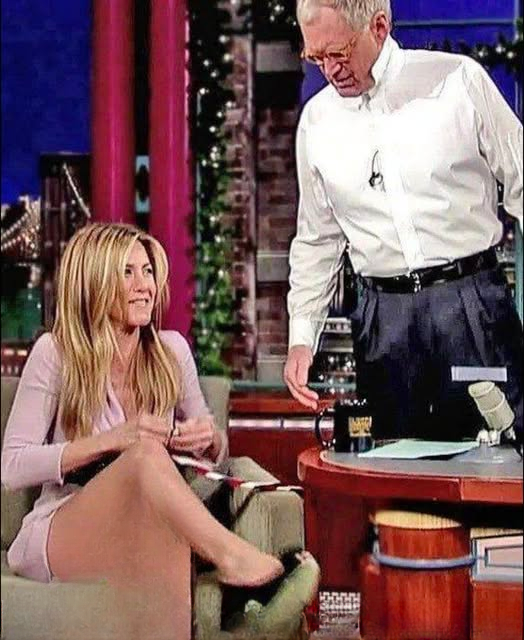David Letterman, long celebrated as a titan of late-night television, is now being reexamined under today’s cultural lens—particularly regarding how he treated female guests. One interview that has repeatedly resurfaced is his 2006 conversation with Jennifer Aniston, promoting The Break-Up. Aniston appeared poised and professional, dressed in black shorts and a stylish blouse. Yet instead of discussing her film, Letterman repeatedly commented on her appearance. “That’s a tremendous outfit,” he said.
He went further, remarking, “You can only wear that if you have lovely, well-shaped, muscular, lengthy legs.” Aniston laughed politely, attempting to redirect the conversation to her work, but Letterman continued, fixating on her legs and adding, “I hope somebody is TiVoing this because I can’t stop looking at this shot.” At the time, the exchange felt uncomfortable; now, revisited through today’s perspective, it comes across as cringeworthy and inappropriate.
This wasn’t an isolated moment. In a 1998 interview, Letterman surprised viewers by grabbing Aniston’s neck and playfully sucking on a strand of her hair. She recoiled, visibly unsettled, as he handed her a tissue. That clip resurfaced in 2021, reigniting discussions about the casual misogyny often normalized in late-night television at the time.
Despite these uncomfortable interactions, Aniston returned to The Late Show on multiple occasions, consistently maintaining her composure and professionalism. She navigated these encounters with grace, never allowing the awkwardness to overshadow her work or her presence on-screen.
During a 2008 visit, she even gifted Letterman a necktie, which led to more suggestive comments. Though such banter was often considered part of the show’s humor in that era, it is now widely recognized as inappropriate and emblematic of a culture that tolerated objectifying behavior toward women in Hollywood.
Looking back, these moments underscore how normalized certain types of commentary once were, particularly in male-dominated spaces like late-night TV. While audiences laughed or looked away at the time, modern reassessments shine a light on the subtle—and sometimes overt—ways women were often reduced to their appearance or body on national television.
They also reveal the evolution of societal standards around consent, respect, and professionalism. What might have been laughed off as harmless flirtation decades ago is now recognized as behavior that could make someone feel uncomfortable, objectified, or unsafe.
For Aniston, these interviews reflect both the challenges she faced and her resilience. She continued to maintain her dignity while navigating the dynamics of male-dominated talk shows, a skill many female actors had to develop to survive and succeed in Hollywood.
The resurfacing of these clips serves as a reminder of the systemic issues that persisted in entertainment for years. They also help contextualize the ongoing cultural shift, illustrating why movements like #MeToo have been so necessary in addressing normalized harassment.
Today, watching these interviews is instructive: they show both how far society has come and how vigilance is required to ensure respect is maintained in public and professional spaces. They also highlight the courage of women like Aniston, who managed to thrive despite being subjected to uncomfortable and inappropriate commentary.
Letterman’s interactions with Aniston, and similar moments from other guests, provoke reflection on the responsibility of hosts, producers, and networks in shaping the culture of their shows. They remind audiences that humor or charm should never come at the expense of another person’s comfort or dignity.
Ultimately, revisiting these interviews is not about shaming the past but understanding it. It allows viewers to recognize the patterns of behavior that were once tolerated, celebrate those who navigated them with resilience, and continue advocating for a culture of respect, inclusivity, and professionalism on-screen.
